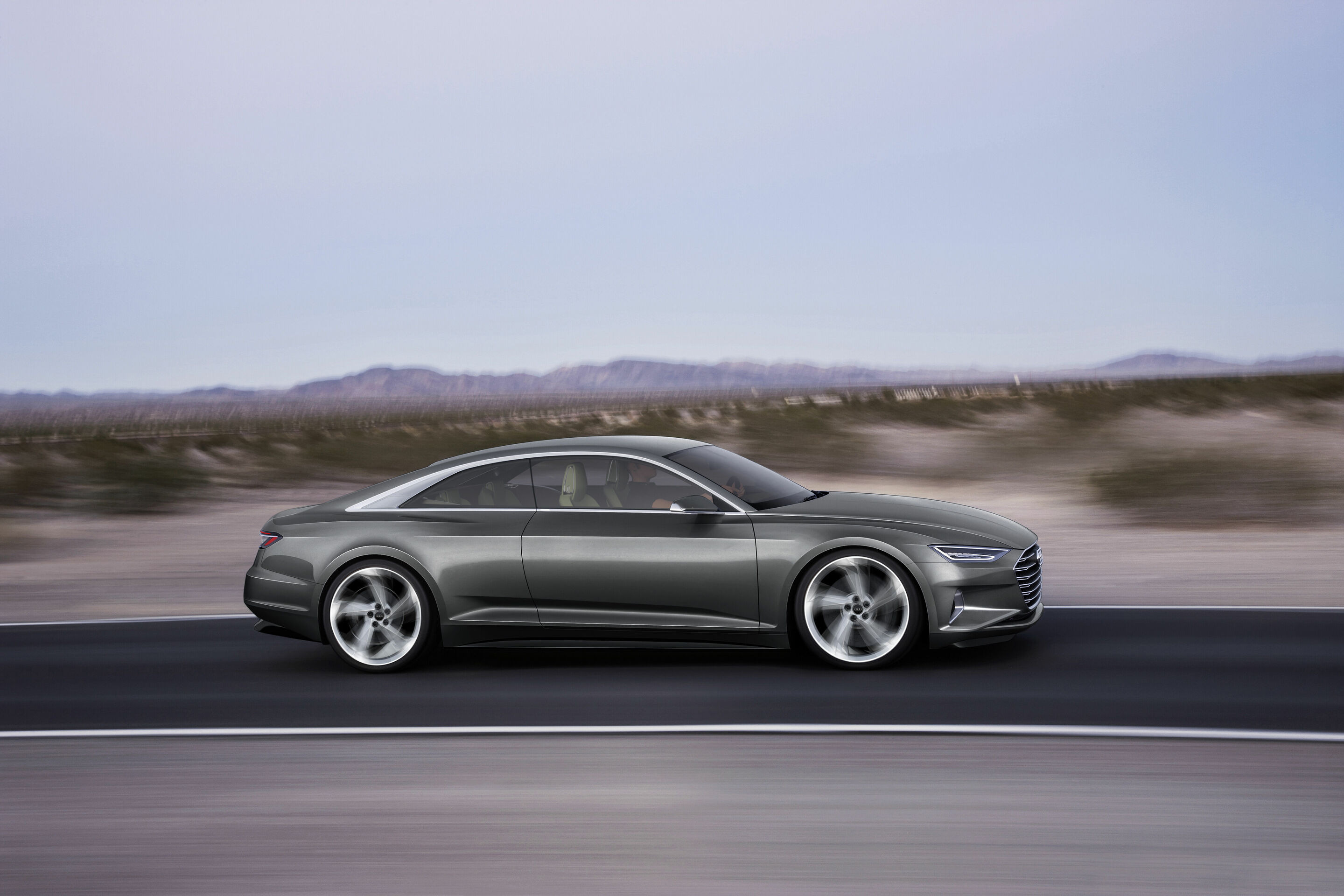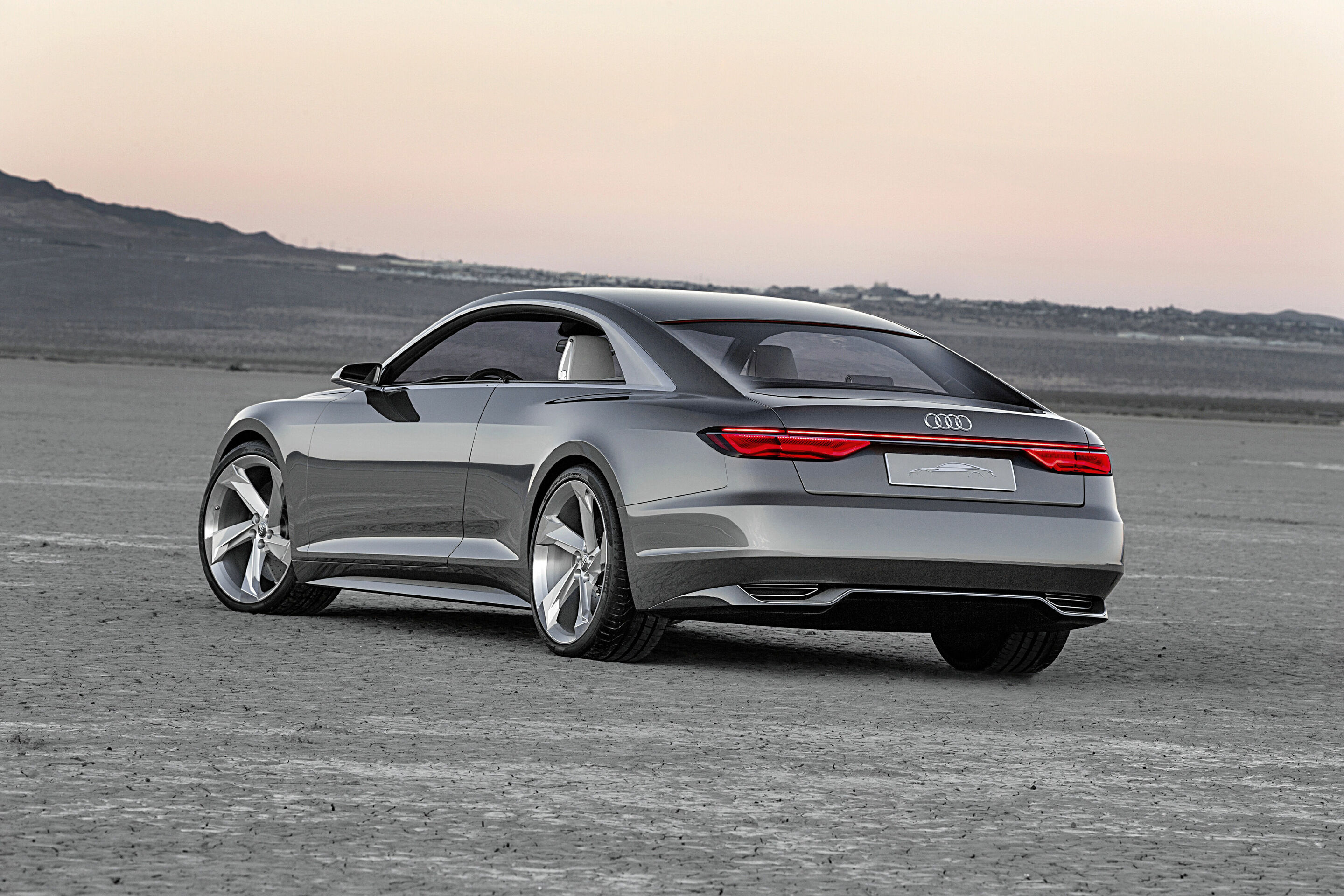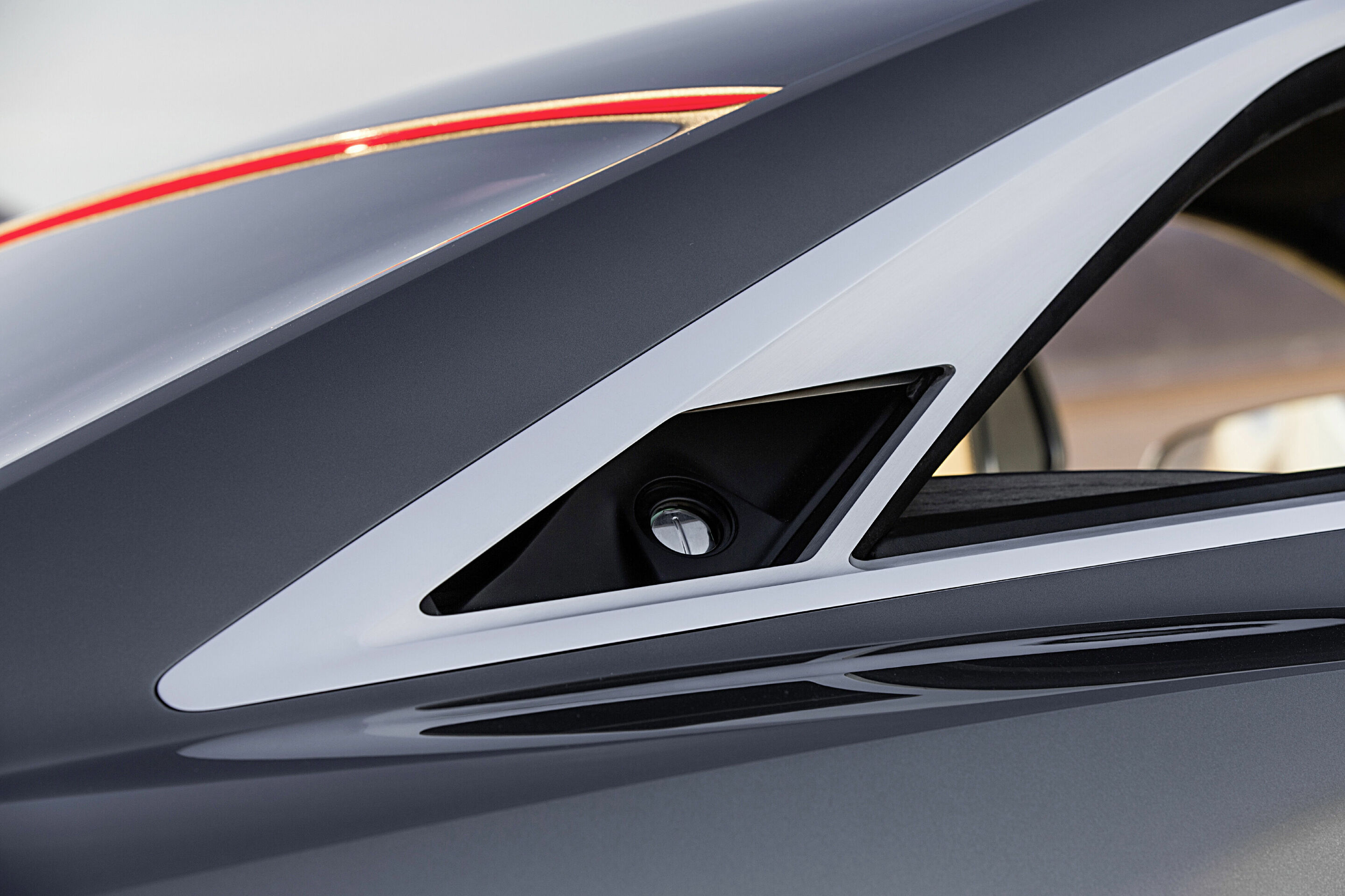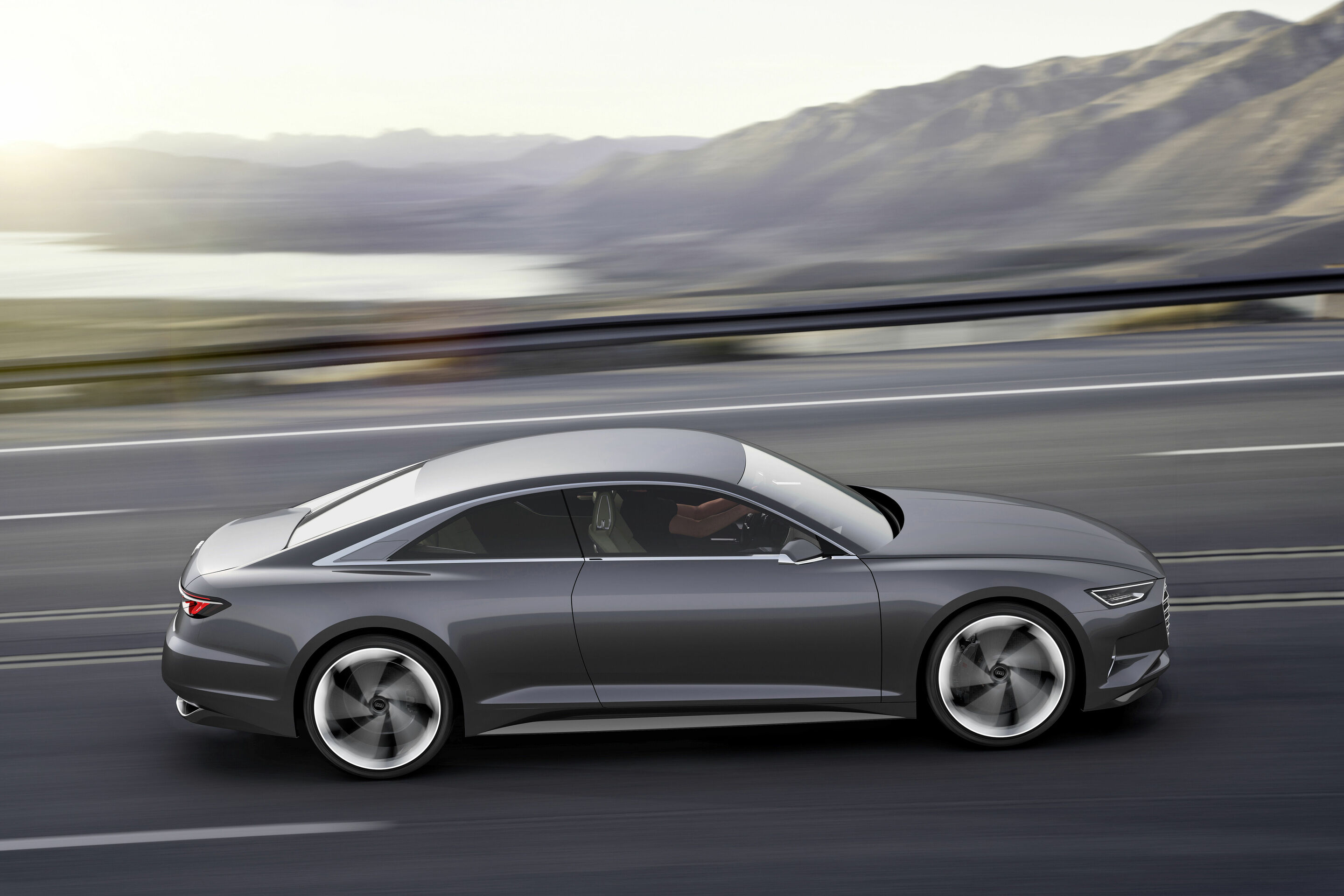Audi prologue piloted driving
Besides lots of electronics highlights and exhibits, Audi will also show sophisticated innovations in series production cars and studies at CES. The Audi prologue piloted driving showcar provides a glimpse of the future, while the Audi TT Roadster*, Audi RS 7 Sportback* and Audi R8 LMX* demonstrate high-tech solutions available today. In addition, CES visitors can experience the interface concept and the connectivity of the new Q7 which will see its world premiere one week later in Detroit.
Heralding a new design era: the Audi prologue piloted driving showcar
The Audi prologue piloted driving show car is a focus at CES. It not only stands for a new design era, but also integrates many innovations in the areas of connectivity, infotainment and user interface which Audi will be showing at 2015 CES. In this connection, this show car’s laser matrix headlights and perimeter sensorics will demonstrate how the car of the future will become ever more of an assistant to its occupants. After all, the Audi prologue piloted driving stands for the state of technology, which includes piloted driving.
A novel laser scanner, several video cameras, ultrasound sensors mounted out of sight and front and rear sensors, themselves invisible, all cooperate in data capture. The central controller known as zFAS (zentrales Fahrerassistenzsteuergerät, central driver assistance controller) is the keystone of piloted driving. This compact master unit calculates a comprehensive impression of the car’s perimeter based on the signals provided by the scanners, the camera and the sensors.
At a length of 5.10 meters (16.7 ft), a wheelbase of 2.94 meters (9.6 ft), a width of 1.95 meters (6.4 ft) and a height of 1.39 meters (4.6 ft) the large luxury-class two-door coupé the Audi prologue is somewhat shorter and lower than today’s production A8*. A single frame integrated into the vehicle architecture and bearing the Four Rings dominates its low-slung front end. The large radiator grille has been widened significantly, and it is positioned lower than on today’s production models.
The headlights – shaped like wide, flat wedges – are located with their tips above the Singleframe. High-resolution matrix laser technology is yet another instance of Audi breaking new ground in design and function.
In side profile, the Audi prologue’s flowing silhouette expresses the car’s forward-moving character. It balanced proportions equally emphasize the front and rear wheels – a clear reference to the quattro DNA of Audi. The mighty wheels are set in widely flared wheel arches; they are 22 inches in diameter and are fitted with tires sized 285/30.
The rear section of the Audi prologue also breaks with conventions. It is reminiscent of the side and rear appearance of a luxury yacht. Its separate tailgate means the Audi prologue piloted driving marries the practical strengths of a sedan with the aesthetic advantages of a coupé.
Its LED taillights made from 3D glass have also been designed anew yet are still characteristic of Audi. The taillight runs across the car’s entire width, illuminating the frame of the recessed glass volume, as fine lines seem to hover amid the lamps. The brake light is set deeply inside the lamp. When it is activated, it appears to be approaching the viewer to attract even more attention. The play on different levels and the switch between two- and three-dimensional effects endows the taillights with a very special dynamic.
Innovative: the interior and control concept
On boarding the car, this grand coupé’s passengers are greeted by an "electronic butler." An intelligent software identifies the user by his or her smartphone or smartwatch and adjusts the seats and the air-conditioning to suit. The system also makes recommendations for music and route planning that are oriented towards the owner’s preferences. The Easy Slot system, an advanced development of the Audi phone box, is located under lids in the console on the central tunnel. It can mechanically draw in and store smartphones, connect them with the onboard infotainment and simultaneously charge them
Generous space: the interior
Tautly stretched lines and slender geometric forms give the interior a bright and clear ambiance. The instrument panel has a light and elegant appearance with its strictly horizontal layout that is not interrupted anywhere, and it emphasizes interior width.
It slopes down towards the interior on two levels. The upper level is positioned like a roof above the Audi virtual cockpit future – an evolution of the Audi virtual cockpit – and above the line of air vents. It is part of a wrap-around concept encompassing the driver and the front-seat passenger.
A second wrap-around connects the front and rear zone of the interior. On activation of the sound system, a novel sound spoiler emerges from the hat rack to create Audi’s typical premium sound.
Full-width display: the Audi virtual interior
Embedded in the elegant architecture is a radically innovative display and control concept, the cockpit of the future, which completely does away with switches.
Across its full width, the front of the instrument panel is designed to be a display surface which integrates three touch displays. The display to the left of the steering wheel controls the lighting and assistance systems functions. The driver-oriented operating unit to the right contains media controls.
The Audi virtual cockpit future offers a glimpse into the future of the digital cockpit: High-resolution displays and three mirrors generate a virtual stage on three levels – a fascinating view with visual depth. Staggering information at different levels makes it better structured and easier for the driver to comprehend. The content and colors of the Audi virtual cockpit future change as a function of driving style – in sporty driving for instance, the display switches to Sport mode with especially vivid presentation of information such as engine speed, temperatures and charger pressure.
The front passenger faces a widescreen display integrated into the full surface of the instrument panel; it is used to operate the entertainment features with utmost convenience, enabling digital interaction with the driver for the first time. It is operated via gestures. A brief swipe by the copilot is all the driver needs to accept and transfer a preconfigured route into the Audi virtual cockpit future.
On the center tunnel console sits a fourth flexible touch display for climate control, handwriting input and other car settings. This display consists primarily of an extremely thin, bendable OLED film (OLED: organic light emitting diodes) and displays extremely sharp images rich in contrast. When not in use, the OLED display is integrated flush to the center console and is nearly invisible. When the car is started, the flexible display stands up. Its curved shape ensures a constant distance to the hand, making for better ergonomics. When operating the display, the wrist rests on the low-positioned gear selector lever of the eight-speed e‑tiptronic.
Sporty, convenient and efficient: the technology
The technology of the Audi prologue is as sophisticated as its interior is thrilling. Its hybrid powertrain with a combined output of 505 kW (677 hp) and 950 Nm (700.7 lb‑ft) of torque, delivers breathtaking performance. It takes this two-door coupé from 0 to 100 km/h (62.1 mph) in 3.5 seconds. Fuel consumption as measured under the New European Driving Cycle is just 7.9 l/100 km (29.8 US mpg) on average. This is equivalent to CO2 emissions of 185 grams per kilometer (297.7 g/mi).
The biturbo V8 with direct fuel injection puts out 445 kW (597 hp) and 700 Nm (516.3 lb-ft) of torque. Another 50 Nm (36.9 lb-ft) are available in overboost mode, which the driver can actuate for about 15 seconds at a time. The 4.0 TFSI is meshed with a disc-shaped e-motor integrated into the eight-speed-e-tiptronic gearbox. The automatic transmission transfers both kinds of torque to the quattro permanent all-wheel drive system. The electrical energy of the hybrid drive comes from a rear-mounted lithium-ion battery with a capacity of 2.6 kWh. This enables a pure electric range of about three miles.
For the best networking experience: Audi connect
The Audi prologue piloted driving show car features the connect portfolio including an integrated LTE module. The Audi smartphone creates an onboard connection to Apple Car Play and Google Android Auto. If an iOS or Android cellular phone is connected to the USB port, the respective environment opens in the Audi smartphone interface. Both are tailored for use in the car.
Interaction with the Audi prologue piloted driving is possible via a smartwatch app enabling the user to access, lock and start the car. Users can also display up-to-the-minute vehicle information on their smartwatch and make configuration changes. For instance, a driver can call up the car’s remaining range or obtain directions back to his or her car.
Light technologies in the Audi prologue piloted driving show car
The car’s headlights feature Audi’s high-resolution matrix laser technology. Matrix laser technology opens up not just new avenues in design, but enables all-new possibilities.
The headlight’s pupils consists of a projection lens with a laser as its source of light. This generates a high-resolution matrix which illuminates the entire roadway. Set below this element are five synthetic lenses enhancing the headlights. They are fed via a glass-fiber strand and are optically encased in a delicate lightweight structure. Thanks to the new laser technology, light designers have been able to create a light, compact and elegant shape which provides the eyes for the "face" of the Audi prologue piloted driving. At CES, a dedicated exhibit will demonstrate the showcar’s matrix laser technology in all its details.
Light functions will be digitally animated. The car "greets" its driver on unlocking by switching on daytime running lights and taillights in a rapid movement from the car’s center to the edges. Subsequently, the matrix laser headlights’ reference cycle activates itself. These pupil-shaped headlight segment seem at first to move right, then left, after which all segments light up fully.
In designing the taillights, designers eschewed conventions and used 3D glass making the taillights benefit from all of the advantages of the new design leeway and run across the entire width of the car. Fine lines in the 3D glass appear to hover inside the lamp. The brake light is located deep inside the lighting unit. When braking, the bottom of the 3D imprint is also illuminated, which makes the light appear to move towards the observer.
The dynamic turning signal runs through the three-dimensional glass volume in a 200-millisecond sequence from inside to outside. The reversing light also makes an appearance from the car’s center to the edges, another first. Though it is transparent and sits below a chrome strip, rendering it almost invisible, it will create a significantly increased level of attention in drivers following behind on activation. This configuration on different levels, and the alternation between 2D and 3D lighting provides the taillights with an entirely new dynamic.
Purism in top shape – the Audi TT Roadster.
Purism in its most beautiful shape: Audi presents the new TT Roadster* at CES in Las Vegas. This compact two-door model sets new standards in design, control and display concept as well as driveablility and user-friendliness.
The TT Roadster demonstrates its puristically sporty character from the moment the user opens its door. Switch on the ignition, and the Audi virtual cockpit comes alive. It presents all information in brilliant, vivid graphics, from the navigational map to the digital rev counter in the TT Roadster. Thanks to an all-new operating logic oriented on the concept of modern smartphones and including a free-text search, the MMI terminal requires a mere six fixed keys.
The infotainment program features a modular structure. Its pinnacle is MMI navigation plus with MMI touch featuring the second-generation modular infotainment matrix with the Tegra 30 graphics processor from NVIDIA. Audi connect as a complement operates on the fast transmission standard LTE (Long Term Evolution) and integrates a WLAN hotspot to bring customized Audi connect service into the car. Innovations in this area include an online media streaming offering, where the Audi MMI connect app enables access to services such as Aupeo! and Napster.
The Audi phone box makes it easy to connect a smartphone to the car, while the seatbelt microphone ensures excellent speech quality in telephone calls even with the top down. Another highlight is the simplified voice control system. The system now understands phrases from everyday language, meaning that hundreds of command variations are possible for each function. A special acoustic experience is provided by the optional Bang & Olufsen Sound System with its 680 watts of output power and twelve speakers in the open TT.
The electrically powered cloth top fits in perfectly with the car’s athletic design and its philosophy of strict weight reduction. Handling is precise, too. This compact roadster, just 4.18 meters (13.7 ft) long, eagerly turns into curves thanks to its sensitive and direct steering.
The newly designed quattro permanent four-wheel drive brings driveability together with stability to create high fascination. The Audi drive select can be set to dynamic mode ant the ESC stability control to “sport” for maximum system dynamics. The new TT Roadster will now purposely steer into curves on lifting the accelerator, permitting controlled drifts under loads with a low friction coefficient. At the end of the curve, the car’s front wheels will return the car to a straight line.
All three engines offer ample power even at low rpms. At the top is the 2.0 TFSI in the TTS Roadster* generating 228 kW (310 hp), the engine accelerating dynamically all the way to almost 7,000 rpms with a thrilling sound to match. 0 to 100 km/h (62.1 mph) is achieved in 4.9 seconds.
Power and elegance: the Audi RS 7 Sportback
Audi has sharpened the RS 7 Sportback* in many areas. Its 412 kW (560 HP) 4.0 TFSI with a torque of 700 Nm (516 lb-ft) translates into impressive performance. All this at an average of 9.5 l/100km (24.8 mpg) and CO2 emissions of 221 g/km (356 g/mi). An eight-speed tiptronic tuned for sporty performance feeds the biturbo 8-cylinder engine’s power to the quattro permanent all-wheel drive. Customers may add the optional sport differential, which actively distributes the power between the rear wheels.
Athletic elegance: the exterior design
Even at first glance, the Audi RS 7 Sportback reveals its dynamic character – its long hood, its sporty and flowing C-pillars and a sharply sloping rear end form an overall impression of athletic elegance. New design details add striking touches.
All lighting functions use light-emitting diodes as standard. The latter are optionally available with Audi’s innovative Matrix LED technology and darkened covers. This offer includes turn signals with dynamic display at the front as well. It is standard at the rear in all cases.
In the elegant black interior dominated by the RS sports seats, the designers have unobtrusively reworked some areas. The standard MMI navigation plus with MMI touch uses the latest-generation modular infotainment platform. Its highlight is the high-performance Tegra 30 graphics processor from Audi’s partner NVIDIA.
Audi connect also provides tailored Internet services for the driver: from navigation based on Google Earth and Google Street View to Facebook and Twitter. Drivers can also read, create and send text messages and emails. Among the latest Audi connect services are Online Media Streaming – which grants access to millions of music tracks in the car – and a Bluetooth interface to a linked smartphone’s voice assistant, such as Siri for the iPhone.
The range of driver assistance systems is equally impressive. Its pinnacle is adaptive cruise control with stop&go function. Audi side assist, which uses radar to secure the rear of the car when changing lanes, now works closely together with Audi active lane assist, which prevents unintended lane changes. Important information can be called up via the optional head-up display.
The Audi R8 LMX – the brand’s dynamic spearhead
419 kW (570 hp), 0-100 km/h (62.1 mph) in 3.4 seconds – the Audi R8 LMX offers breathtaking performance and groundbreaking technology. This edition model of the R8 family* is the first series production car in the world to feature laser highbeams. A laser module in each headlamp generates a light cone with twice the range of a full-LED highbeam. The laser spot, which is activated at speeds of 60 km/h (37.3 mph) and above, supplements the LED high beam.
Limited run of 99: the Audi R8 LMX edition model
The Audi R8 is the brand’s dynamic top model. The R8 LMX is available exclusively as a coupé with a production run limited to 99. Its 5.2-liter aspirated V10 produces 540 Nm (398.3 lb-ft) of torque at 6,500 rpm. This hurls the car from 0 to 100 km/h (62.1 mph) in 3.4 seconds. Top speed is 320 km/h (198.8 mph), and average consumption is 12.9 liters of fuel per 100 kilometers (299 grams CO2 per kilometer) [18.2 US mpg/481.2 g/mile].
Equipment, data and prices specified in this document refer to the model range offered in Germany. Subject to change without notice.
Recent MediaInfos
-
 Audi Sport customer teams close season with remarkable results
Audi Sport customer racing has concluded a challenging season with convincing results. The brand’s customer teams won 206 of 734 races worldwide, achieving a success rate of 28.1 percent. Two overall victories in 24-hour races in Germany and the United Arab Emirates as well as a 12-hour overall victory crown the season of the customers.
Audi Sport customer teams close season with remarkable results
Audi Sport customer racing has concluded a challenging season with convincing results. The brand’s customer teams won 206 of 734 races worldwide, achieving a success rate of 28.1 percent. Two overall victories in 24-hour races in Germany and the United Arab Emirates as well as a 12-hour overall victory crown the season of the customers. -
 Audi starts production of electric models at its new plant in China
Audi FAW NEV Company, a cooperation project between Audi and long-standing partner FAW, has commenced production of all-electric Audi models. The company and its new state-of-the-art plant form a key component of the strategy Audi has adopted for the Chinese market. The new production site in Changchun is the first in China to exclusively produce fully electric Audi models based on the PPE platform, beginning with the Q6L e-tron family, followed by a market-specific version of the Audi A6 e-tron.
Audi starts production of electric models at its new plant in China
Audi FAW NEV Company, a cooperation project between Audi and long-standing partner FAW, has commenced production of all-electric Audi models. The company and its new state-of-the-art plant form a key component of the strategy Audi has adopted for the Chinese market. The new production site in Changchun is the first in China to exclusively produce fully electric Audi models based on the PPE platform, beginning with the Q6L e-tron family, followed by a market-specific version of the Audi A6 e-tron. -
 Illuminating insights!
Lighting technology and lighting design may seem to have a lot in common at first glance but, in fact, a careful balancing act between aesthetics and functionality takes place behind the scenes. In this article, Stefan Staudacher, head of rear lighting development, and lighting designer Christoph Häußinger shine some light on how designers and developers work together to find the best solutions, despite their different requirements.
Illuminating insights!
Lighting technology and lighting design may seem to have a lot in common at first glance but, in fact, a careful balancing act between aesthetics and functionality takes place behind the scenes. In this article, Stefan Staudacher, head of rear lighting development, and lighting designer Christoph Häußinger shine some light on how designers and developers work together to find the best solutions, despite their different requirements. -
 Audi Tradition to commemorate numerous anniversaries in 2025
With the “Anniversary Dates 2025” booklet, Audi Tradition is showcasing the most important moments in the product and company history of Audi, which is as eventful as it is diverse. Audi historians have selected a total of 27 dates to commemorate in 2025.
Audi Tradition to commemorate numerous anniversaries in 2025
With the “Anniversary Dates 2025” booklet, Audi Tradition is showcasing the most important moments in the product and company history of Audi, which is as eventful as it is diverse. Audi historians have selected a total of 27 dates to commemorate in 2025. -
 Geoffrey Bouquot named board member for Technical Development at Audi
Just in time for the planned restructuring of Vehicle Development in line with matrix organization principles, Audi is confirming a structural change: effective January 1, 2025, Geoffrey Bouquot will take over as head of the Technical Development division, which will be merged with his previous Innovation and Software-Defined Vehicle (SDV) division.
Geoffrey Bouquot named board member for Technical Development at Audi
Just in time for the planned restructuring of Vehicle Development in line with matrix organization principles, Audi is confirming a structural change: effective January 1, 2025, Geoffrey Bouquot will take over as head of the Technical Development division, which will be merged with his previous Innovation and Software-Defined Vehicle (SDV) division.




